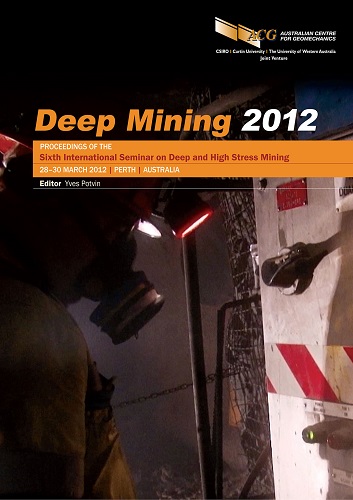A feasibility study on adopting coiled tubing drilling technology for deep hard rock mining exploration

|
Authors: Mokaramian, A; Rasouli, V; Cavanough, G Paper is not available for download Contact Us |
DOI https://doi.org/10.36487/ACG_rep/1201_36_mokaramian
Cite As:
Mokaramian, A, Rasouli, V & Cavanough, G 2012, 'A feasibility study on adopting coiled tubing drilling technology for deep hard rock mining exploration', in Y Potvin (ed.), Deep Mining 2012: Proceedings of the Sixth International Seminar on Deep and High Stress Mining, Australian Centre for Geomechanics, Perth, pp. 487-499, https://doi.org/10.36487/ACG_rep/1201_36_mokaramian
Abstract:
In mineral exploration, the main purpose of drilling is to acquire a large number of samples to test them in the lab and obtain information about the vertical and lateral distribution of the geological formations, the structural regime, ore and its grade. This would determine if the site is feasible for further investigations and studies. With this in mind, perhaps obtaining core samples over whole overburden is not always essential and having cuttings of small sizes could be used for the analyses needed during the exploration phase. If this is considered to be true, then drilling small size holes as fast as possible and obtaining the samples to the surface would be a good alternative with several advantages over conventional drilling methods for deep hard rock mineral exploration. Drilling deep wells of the order of a few kilometres is very common in oil and gas industry; this justifies the idea of adopting the existing technologies into mineral exploration drilling. The need to drill deep boreholes for mineral exploration purposes has raised the attention to investigate the feasibility of using the coiled tube (CT) drilling for such applications. CT is a continuous length of electric resistance welded (ERW) tubular pipe with no connection, in different lengths and is spooled onto a take-up reel during the first stage of manufacturing. While advances have been made in the CT technology in the oil and gas industry within the past few decades, introducing this system for mining applications is subjected to different challenges. In this paper a review of the CT system and its capabilities and limitations will be presented. Technical design parameters for a CT system will be listed and discussed in detail. This will enable us to identify the areas where modifications are required for the CT technology – had it been used for mining exploration drilling. Drilling fluid specifications and environmental impact are some of the parameters to be compared between a typical mining, and oil and gas drilling. This study will conclude possible adoption of CT system for mining exploration drilling and provide the range of modifications required for this purpose to the current CT technology. This study is part of the Deep Exploration Technologies (DET) programme which is a Cooperative Research Centre (CRC) planning in providing research solutions for drilling deep mineral deposits.
References:
Albright, J., Dreesen, D. and Anderson, D. (2003) Road Map For A 5000-Ft Microborehole, Los Alamos National Laboratory (LANL).
Atlas-Copco (2010) Exploration Drilling, First Edition, Sweden.
Beaton, T. and Seale, R. (2004) The Use of Turbodrills in Coiled Tubing Applications, paper presented to SPE/ICoTA Coiled Tubing Conference (SPE 89434), Houston, Texas, U.S.A.
Blount, C.G., Hearn, D.D., Payne, M.L. and Sathuvalli, U.B. (1998) Weight on Bit in Coiled Tubing Drilling: Collection and Analysis of Field Data, paper presented to SPE/ICoTA Coiled Tubing Roundtable, (SPE 46008), Houston, Texas.
Byrom, T.G. (1999) Coiled Tubing Drilling in Perspective, Journal of Petroleum Technology, Vol. 51 (SPE 51792).
Dietrich, J., Kowal, M., Clauser, C. and Doncker, R.W.D. (2009) A Feasibility Study Regarding Micro-Drilling Technology, E.ON Energy Research Center, Germany.
Eskin, M. and Maurer, W.C. (1997) Advanced Downhole Drilling Motors, Maurer Engineering Inc.
Galbierz, B.E. and Oglesby, K.D. (2005) Advanced Mud System for Microhole Coiled Tubing Drilling, Final Report, U.S. Department of Energy, Bandera Petroleum Exploration LLC, IMPACT Technologies LLC.
ICoTA (The Intervention & Coiled Tubing Association) (2005) An introduction to Coiled tubing: History, Applications, and Benefits, .
Littleton, B., Nicholson, S. and Blount, C. (2010) Improved Drilling Performance and Economics Using Hybrid Coiled Tubing Unit on the Chittim Ranch, West Texas (IADC/SPE 128926).
Lyons, W.C. and Plisga, G.J. (2005) Standard Handbook of Petroleum & Natural Gas Engineering, 2nd ed, Elsevier Inc., United States of America.
Melamed, Y., Kiselev, A., Gelfgat, M., Dreesen, D. and Blacic, J. (2000) Hydraulic Hammer Drilling, Journal of Energy Resources Technology, Vol. 122 (1), pp. 1–7.
NETL (National Energy Technology Laboratory) (2005) Coiled Tubing: State of the Industry and Role for NETL, U.S. Deparment of Energy.
Pierce, K.G., Livesay, B.J. and Finger, J.T. (1996) Advanced Drilling Systems Study, SAND95-033, U.S. Department of Energy (DOE).
Reich, M., Picksak, A., John, W. and Regener, T. (2000) Competitive Performance Drilling with High-Speed Downhole Motors in Hard and Abrasive Formations, paper presented to IADC/SPE Drilling Conference, (IADC/SPE 59215), New Orleans, Louisiana.
© Copyright 2024, Australian Centre for Geomechanics (ACG), The University of Western Australia. All rights reserved.
View copyright/legal information
Please direct any queries or error reports to repository-acg@uwa.edu.au
View copyright/legal information
Please direct any queries or error reports to repository-acg@uwa.edu.au